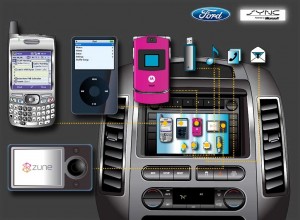
Ford's Sync system has become one of the more popular - and most flexible entries into the expanding world of Telematics.
Telematics – wireless communication to and from vehicles – has reached critical mass, or so seemed the consensus among attendees at this week’s Telematics Detroit 2009 in Novi, Michigan. Telematics – wireless communication to and from vehicles – has reached critical mass, or so seemed the consensus among attendees at this week’s Telematics Detroit 2009 in Novi, Michigan.
“Every major automaker is planning to deploy the technology,” according to Phil Magney, vice president of iSuppli Corporation and head of the firm’s automotive practice. “Are telematics services necessary to sell cars? The consensus, increasingly, is ‘yes,'” he said.
That’s because car buyers, especially younger ones, expect to enjoy much the same “connectivity” in their vehicles as they have in their homes and other gathering places. Cars have to accommodate iPods and other MP3 players, smartphones, and whatever other hot new devices the consumer electronics industry can dream up over the course of a vehicle’s lifecycle.
Trouble lies in the mismatch between the short product development cycles common to consumer electronics and the much longer timeframes required for cars. Designing for an unpredictable future is a complex problem, but automotive system suppliers are responding with so-called open development platforms that they promise will be future proof. The platforms are similar if not identical to those now being used by third party vendors developing smartphone applications. Automakers know they need to capitalize on that same kind of creativity, though they have to be much more careful in doing so. Either of two alternative strategies for delivering telematics services is acceptable, according to Magney and other speakers at the Novi conference:
Either of two alternative strategies for delivering telematics services is acceptable, according to Magney and other speakers at the Novi conference:
- Embedding telematics intelligence into a vehicle, as OnStar does, with a dedicated cell phone system paid for by the automaker. The system is available whether or not a driver brings a personal cell phone into the vehicle, benefiting safety applications such as automatic crash notification. “High touch” systems like OnStar, or BMW Assist, put drivers in contact with live operators. Embedded systems also have an advantage in gathering performance and diagnostic data from the vehicle. Diagnostic information is useful to dealers in building customer relationships, and the virtual “pipes” between an automaker and an end customer represent significant savings; for example, when updates to vehicle control software can be downloaded wirelessly in lieu of a recall.
- Facilitating the use of mobile devices that the vehicle owner pays for and carries into the vehicle, as Ford does with its SYNC system. The devices, paired with the vehicle system, provide a link to the outside world.
Whichever strategy an automaker selects, given the lack of near-term revenue potential, it is vital for automakers to minimize development time and costs, maximize flexibility, and avoid long-term commitments to technology that may become obsolete. Automotive suppliers at Telematics Detroit spent considerable time talking about development platforms and partnerships.
Tier One supplier Continental, for example, used the conference to launch an open platform called AutoLinQ that will use Google’s Android operating system. Third-party developers are using Android to create applications for mobile devices; for example, social network applications linked to geographic locations to help people find their friends, personal activity planners, city guides, and video messaging services. Continental hopes that with AutoLinQ, some of those same developers will build or tailor applications for cars.
Continental vice president Herbert Halamek stressed that information brought into cars will be integrated in a safety-minded way, which means that some applications may not be usable while vehicles are moving.
Continental, with AutoLinQ, may compete with end-to-end telematics service providers like Hughes Telematics, ATX/Cross Country, or Airbiquity. It may also compete for business with the Genivi Alliance, another open source platform for building automotive software applications. At the conference, the Genivi Alliance announced that Freescale Semiconductor, Texas Instruments, and MontaVista Software have signed on as members. Founding members of the Alliance include BMW Group, Wind River, Intel, GM, PSA, Delphi, Magneti-Marelli, and Visteon.
QNX Corp., which supplies middleware – software that connects other software components together – offers a development platform called QNX CAR. At Telematics Detroit, the firm demonstrated an automotive infotainment system that included Pandora Internet Radio. The demo implies that Internet radio, at least as Pandora presents it, will be available in vehicles. Pandora lets a listener choose from a seemingly endless list of artists and genres and responds by creating an ongoing stream of appropriate music.
No timeframe was provided for what some see as the inevitability of in-car Internet radio. Another firm, Jungo Ltd., introduced middleware called MediaCore for developing automotive infotainment systems. The software works with a variety of USB devices and lessens the need for automakers to devote their own engineers’ time to the details of product development.
New partners UIEvolution and the Tweddle Group met at Telematics Detroit a year ago. This year the pair launched a joint venture called UIE Automotive to develop applications for mobile devices, PCs and vehicle navigation screens. UIEvolution has experience in launching mobile applications while Tweddle produces car owner manuals.
“Partnerships were once a barrier, but the automotive industry has begun to cope with that,” said iSuppli’s Magney. “Automakers can choose an end-to-end supplier to design a telematics system, or they could do the design in-house and parse out pieces. There’s nothing wrong with either approach.”
